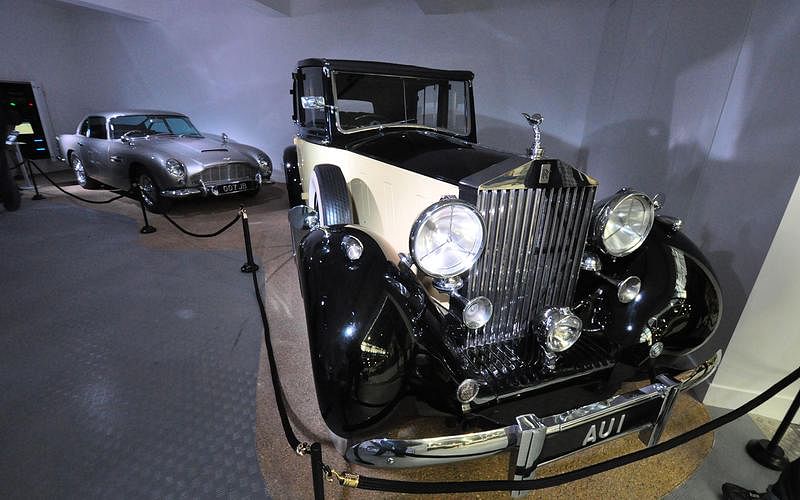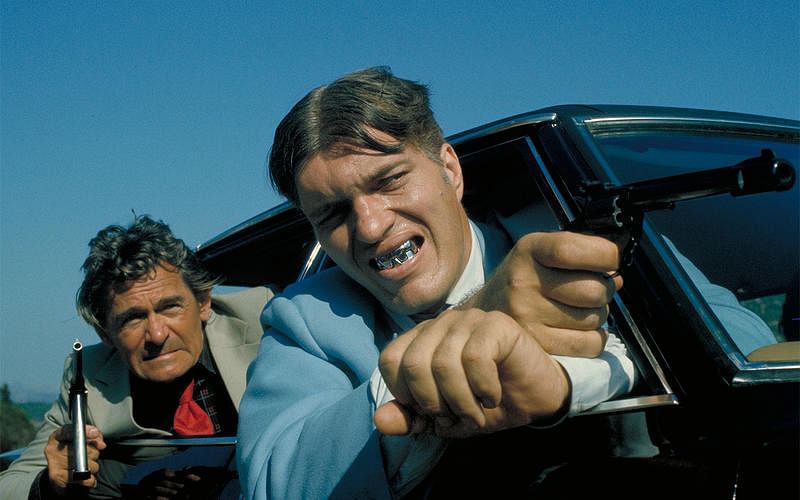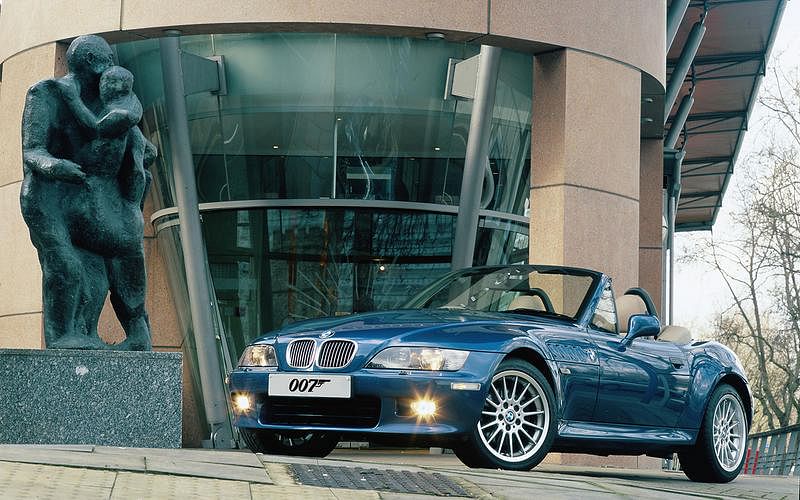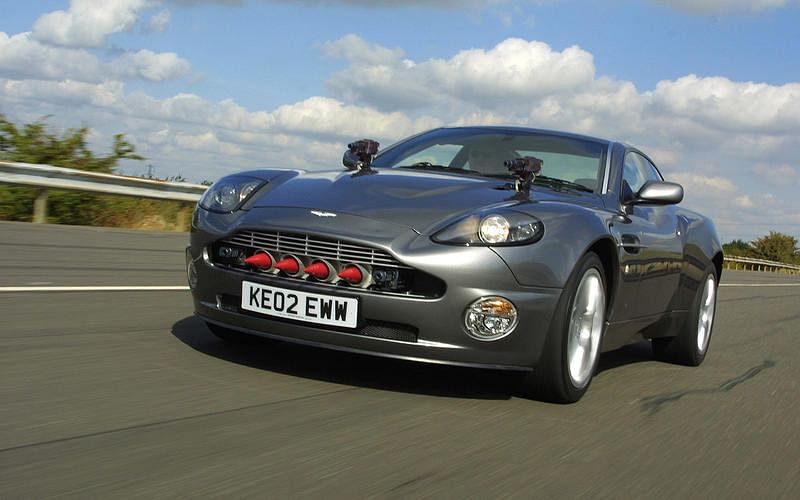Christmas Special: The cars of James Bond
It's Christmas – time to take a look at the cars of the world's least secret secret agent.
Ever since he first roared into action between the pages of Casino Royale over 60 years ago, Commander James Bond has taken his choice of company car almost as seriously as his choice of hand gun, champagne and, er, companion.
So it’s far from reassuring to see just how many dodgy, dire and occasionally disastrous choices he’s made. So forget the missile launchers, ejector seats and amphibious capability let’s look a little closer at the motors behind the myths to see which, if any, really are worthy of the attentions of the world’s least secret agent – and we also suggest some he missed, and take a look at some the villains used too.
Bentley 4.5-litre supercharged (Casino Royale, the book, 1953)

Always thought Bond an Aston man at heart? Think again: back in 1953 Fleming’s first choice of wheels was this blown behemoth. Whisper this, but the ‘blower’ Bentley wasn’t a very good car even when it was new in 1929, let alone 24 years later when Bond got his driving gloves on it. Even WO Bentley hated it, saying to supercharge one of his cars was ‘to pervert its design and corrupt its performance.'
It never won an important race, largely because it broke down a lot. Slow and cumbersome too with that vast Amherst Villiers supercharger slung out in front. It was a terrible choice for Bond in all aspects save its appearance. Which you couldn’t see in a book.
Aston Martin DB2/4 MkIII (Goldfinger, the book – 1959)

Eh? If there’s one thing everyone knows it’s that Bond drives a DB5 in Goldfinger. Except he didn’t. Not at first at least. Before Goldfinger the film, there was Goldfinger the book, the seventh in the Bond canon to issue from Ian Fleming’s pen. It was ‘a pool car’ that Bond chose in preference to a Jaguar 3.4 and like the film car, was the first to feature additional ‘refinements’.
These included reinforced bumpers for ramming purposes, a radio locator and a long barrelled Colt 45 in a hidden compartment under the driver’s seat. Another fact known to few: as a driving machine the MkIII was far more incisive and involving than the DB5.
Aston Martin DB5 (Goldfinger – 1964)

I barely dare say this, but the DB5 is not quite as good as its legend would have you believe. Indeed I’d suggest that were it not for its starring role in Goldfinger, it would now be regarded merely as one of Aston’s better efforts. What it has in its favour are those landmark looks, a classic interior and a pleasantly characterful engine.
Aston Martin DB5 (Goldfinger – 1964)

But a seminal driving experience it is not, dating as it does from an era when Aston Martin had progressed away from thoroughbred, race-proven sports cars it designed in the 1950s, to gentler, softer, more touring oriented cars. Wonderful to park outside the Gstaad Palace Hotel, less of a joy to drive over the mountains to get there.
Rolls-Royce Phantom III (Goldfinger – 1964)

What better car for the plutocratic and apparently Anglophile Auric Goldfinger than the only Rolls-Royce to be powered by a V12 engine until the introduction of the Silver Seraph in 1998? So massive, what little performance it could derive from even a 7.3-litre V12 was possibly blunted by so many of its components being made from gold.
When it was tested Autocar recorded a 0-60mph time of 16.8sec, less than a second quicker than the magazine recorded for a 1.2-litre Dacia Sandero, a fact only surprising until you learn the Roller weighed 3500kg (7700 lb)…
Toyota 2000GT Convertible (You Only Live Twice – 1967)

Almost a brilliant choice for Bond. Not just gorgeous but fascinating to look at and a properly important car too, as Japan’s first truly credible sports car. Its 2-litre, six-cylinder engine gave decent power for the era thanks to a Yamaha twin cam head and triple carburetors and it even handled, rode and steered beautifully for the era.
Toyota 2000GT Convertible (You Only Live Twice – 1967)

And then they discovered Sean Connery was too tall to squeeze comfortably into its cosy confines, a problem they solved by simply sawing the roof off to turn it into a terminally cool convertible. Sadly this is likely also to have had a catastrophic effect on its rigidity and turned a taut, finely honed sports car into a wobbling mess with all the structural integrity of a sandcastle.
Aston Martin DBS (On Her Majesty’s Secret Service – 1969)

An understated Aston by Bond standards with no known gimmickry fitted. Appeared in surprisingly few scenes but is remembered today as being the conveyance in which Mrs Tracy Bond breathed her last courtesy of a bullet from the fabulously entitled Irma Bunt. The DBS had a troubled gestation and was originally intended to have a V8 fitted, but the motor was late, forcing 007 to slum it with the straight six from the DB6.
The DBS V8 did make production, but not in time for the film. It’s most easily told from the six-pot DBS by having alloy instead of spoked wheels.
Mercedes-Benz 600 (On Her Majesty’s Secret Service – 1969)

Bet you didn’t know the identity of the Bond villain’s automotive weapon au choix. Well I can reveal it’s the big Benz limo used not only by Bunt and Blofeld in OHMSS, but by Blofeld again in Diamonds Are Forever and briefly by Kamal Khan in Octopussy.
We should not be surprised: big, austere and menacing, the grosser Benz made perfect transport for bad guys. And they probably enjoyed deploying its potent 300bhp 6.3-litre V8 too, making it more than match for some of the rubbish Bond had to drive from time to time.
Ford Mustang Mach 1 (Diamonds Are Forever – 1971)

One of the last proper American muscle cars before emissions legislations throttled even Detroit’s most massive V8s. With a 7-litre Super Cobra Jet big block motor breathing through a four barrel Holley carb, the Mach 1 made 375bhp and, far more importantly, a monstrous 450lb ft of torque.
The chase in DaF is short and famous for the ‘Stang’s two-wheeled escape through the width restriction (neatly forgetting the fact the diff would have needed to be welded up to maintain any speed) but there’s a far better one featuring a similar car in the original HB Halicki ‘Gone In 60 Seconds.’ One more faintly related fact: the Mach 1 in DaF was being used by Tiffany Case, as played by Jill St John who had been married to Woolworth heir Lance Reventlow who’d driven in Formula 1 in 1960 with his own home-grown Scarab race cars
Lotus Esprit S1 (The Spy Who Loved Me – 1977)

This is a bit more like it? Surely? The early Esprit was sleek, sexy and handled like a dream. In reality however it was also plagued with teething troubles and somewhat inexact in its construction standards.
Lotus Esprit S1 (The Spy Who Loved Me – 1977)

In a thrilling chase scene, the car was expertly driven in reality by Lotus engineer Roger Becker, who understandably knew its handling capability like few others, and it proved brilliant at dodging trucks and exploding sidecars, while also evading these charming fellows in Ford Cortinas.
Lotus Esprit S1 (The Spy Who Loved Me – 1977)

However, if an Esprit really had dived into the sea, it would have needed not only fins in its wheel wells but aqualungs in its glove box too. Remember Bond dropping a fish out of the window as he drove the car up the beach? How did it get in to begin with? My guess is it came in through the panel gaps.
Citroën 2CV6 (For Your Eyes Only – 1981)

I must declare an interest: I am a long time lover of the 2CV and can see no fault in this flawless, thrilling icon of style and driving pleasure. Ok, it’s a shed, a yellow shed full of bullet-holes in this particular case, but for fans of inverse snobbery, the 2CV was actually a very clever and quite cool choice.
Alfa Romeo GTV6 (Octopussy – 1983)

Throughout the history of Bond, no nation has been more under-represented relative to its contribution to automotive history than Italy. There’s the F355 in Goldeneye, but apparently that can’t even get away from an Aston DB5 30 years its senior, and… raise a glass and praise the heavens for the cameo of the Alfa Romeo GTV6 in Octopussy. A rubbish film it may have been, but someone on the production crew clearly knew their onions, or at least their V6-powered transaxle Alfas.
Which is why once Jimmy’s nicked it from some poor woman in a telephone box, it spends the rest of its small time on screen doing extravagant skids and sounding wonderful. And they must have liked it: it doesn’t even get written off in its final scene.
Saab 900 Turbo (The Man From Barbarossa (book – 1991) and others)

Didn’t expect that, did you? Well Bond drove one in three outings, at least if you’re a fan of Bond novels rather than films. And for those of you who’ve figured out that Ian Fleming died long before the Saab appeared, he was not alone in writing Bond literature. Indeed Colonel Sun by the mysterious Robert Markham was actually written by Kingsley Amis. But the man who put Bond in a Saab was John Gardner who wrote 16 Bond novels between 1981-1996.
Can I see Bond in a Saab? Well it came plumb in the middle of the Roger Moore era which even saw the world’s greatest spy rustle up a quiche, so I guess anything’s possible. But do you think it seems remotely right? Me neither.
BMW Z3 (Goldeneye – 1995)

Oh dear oh dear. Had this been a Z3M coupe I’d have been celebrating its existence in the Bond canon. But it wasn’t: filmed before the car went on sale, the Goldeneye Z3 had a 1.9-litre four cylinder engine and while only screen for a matter of seconds, it was long enough to show that those who chose Bond’s car at the time were far more interested in which company paid the most than which car would best suit our most intrepid civil servant.
Aston Martin Vanquish (Die Another Day – 2002)

Another crying shame, not the car this time but the entirely unbelievable and irredeemably lame film it was in. Stripped of its preposterous invisible cloaking, the Vanquish was, in fact, perfect Bond fodder. It wasn’t just beautiful like some of his later Astons, it was muscular and a touch intimidating too.
Aston Martin Vanquish (Die Another Day – 2002)

Fast, loud and beautifully balanced, it was a real driver’s car and even the fact it’s truly flawed – the robotised gearshift is so bad that Aston will retrofit a manual gearbox – seems to suit the character of our superhero.
Aston Martin DB10 (Spectre – 2015)

Bond’s greatest automotive coup to date, not just because it was his first company car to be truly bespoke rather than a highly accessorized off-the-peg model, but because it wasn’t even meant for him. For those who’ve not seen the film, he pinched it from 009.
Aston Martin DB10 (Spectre – 2015)

So trust the Jimster to then go and dump it in the Tiber while, in quite a cool reinterpretation of a very old trick, ejecting himself to (relative) safety through its roof. The car was actually a reclad V8 Vantage – well, 10 reclad V8 Vantages once you’d taken hero cars, stunt cars and promo cars into consideration – styled in house by Marek Reichman’s team at Aston Martin and was Bond’s best transport yet. Probably.
CX-75 (Spectre – 2015)

Bond is not averse to taking on somewhat daunting odds, but Mr Hinx in a CX-75? Of course the CX-75 used in the film didn’t have the hybrid powertrain and super cool little jet turbine range extenders seen on the concept but it still looked like it would swallow the DB10 whole if only Bond villains had quite the same talent as our hero.
Jaguar CX-75 (Spectre – 2015)

But at least we got to see Jaguar’s most ambitious car on the move, even if it was some years after the project got canned.
Now let's take a look at the cars that Bond really should have driven
1960s: Aston Martin DB4 GT

Faster, better looking, wildly more exciting to drive than a DB5 and with proper race heritage, this is possibly the greatest road legal Aston ever. A shame that by the time the first Bond movie came out it was no longer on sale.
1970s: Aston Martin V8 Vantage

This car seems so suited to Bond you’d be forgiven for thinking he designed it himself. In fact he never sat in one and, no, I don’t count the DBS in On Her Majesty’s Secret Service or the Volante in The Living Daylights.
1980s: Bentley Mulsanne Turbo R

A bit of a blunt instrument? Perhaps, but this is decade in which one of Timothy Dalton’s preferred methods of dispatch for the bad guys was the head butt, so it kind of fits the post Rog-renaissance. Four doors or not, the Turbo R is still one of Britain’s most charismatic sporting cars of all time.
1990s: Jaguar XJ220 V12

In both For Your Eyes Only and Spectre, Bond drives a unique car, unavailable to the public. So by the time the 1990s came along he could just as easily have tooled around in a road-going realisation of the original 1988 XJ220 concept car with its vast dimensions, 48-valve V12 motor and four-wheel drive. So menacing Sean Bean would have surrendered on sight.
2000s: Bentley Brooklands

Ok, I admit it you can’t beat the Vanquish, other than with the Vanquish S. But forced to look elsewhere, I’d go for the raffish yet brutish Bentley Brooklands coupe that came with 530bhp V8 and enough torque to pull your house down. Equipped with its own factory standard smoke generator, though providing an ability to blind your pursuers was perhaps not the main reason for its lack of a limited slip differential.
2010s: Aston Martin V12 Vantage S manual

The DB10 looks wonderful and will, I am sure, make a fine Bond car. But of the machines mere mortals can actually buy, the V12 Vantage – ideally converted to manual transmission – is as tailor-made a Bond car as I can conceive.
Copyright @Autocar UK
RELATED ARTICLES
How Venkat Thimaraju Bridged Mines and Machines for Daimler
From a young engineer's vision : Daimler India unleashes next-Gen trucks for India's booming construction and mining sec...
Tata Motors: From Ice Legacy To Electric Intelligence
Tata Motors has a lot riding on the newly launched Harrier EV, coming as it does on a fresh, EV-oriented software platfo...
Complete List of Cars and SUVs Tested by Bharat NCAP
Bharat NCAP has crash-tested 20 models to date, including both ICE-powered vehicles and EVs.





 24 Dec 2017
24 Dec 2017
 8893 Views
8893 Views





 Shahkar Abidi
Shahkar Abidi


 Ketan Thakkar
Ketan Thakkar


